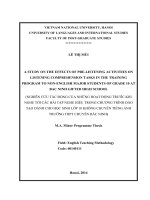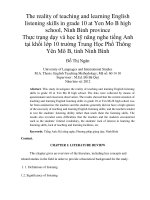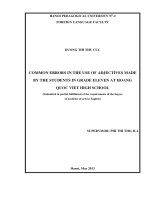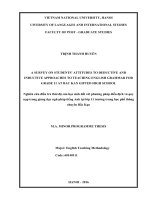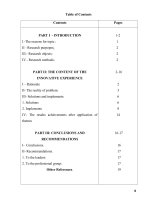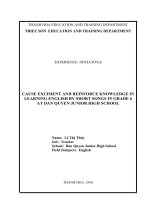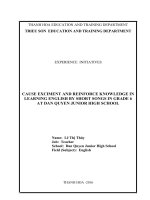Common errors in the use of to infinitives made by the students in grade eleven at bac kien xwowng high school
Bạn đang xem bản rút gọn của tài liệu. Xem và tải ngay bản đầy đủ của tài liệu tại đây (566.36 KB, 53 trang )
HANOI PEDAGOGICAL UNIVERSITY N
o
2
FOREIGN LANGUAGE FACULTY
NGUYEN THI KIEU MIEN
COMMON ERRORS IN THE USE OF TO-INFINITIVES
MADE BY THE STUDENTS IN GRADE ELEVEN AT
BAC KIEN XUONG HIGH SCHOOL
(GRADUATION PAPER SUBMITTED IN PARTIAL FULFILLMENT OF
THE DEGREE OF BACHELOR OF ARTS IN ENGLISH)
Hanoi, 2014
i
Acknowledgement
I would like to take this chance to express my greatest gratitude to Mrs.
Phi Thi Tho, B.A., my supervisor for her invaluable support and careful
guidance as well as encouragement, suggestions and advice throughout the
process of writing this thesis.
Besides, I would like to thank to the librarians of Hanoi Pedagogical
University Number 2 who have helped me in the preparation and writing this
thesis.
I would like to express my thanks to my all beloved lectures who always
motivated and suggested me to finish my thesis soon. Furthermore, I would like
to thank all my friends who never stop encouraging me to finish my thesis.
In addition, I want to express my special thank to students in class 11 at
Bac Kien Xuong High School because of their support in the survey.
Last but not least, I own a debt of gratitude to my beloved family, for their
whole – hearted encouragement and endless support.
ii
Abstract
It is a fact that to-infinitive is one of the essential parts to form a sentence
in English grammar. As well known, to-infinitives are diversified in many
forms, functions as well as usages. It takes learners quite a long time to
understand to-infinitives deeply.
As a result, students of English often make errors when they use to-
infinitives. Therefore, this research is focused on investigating common errors in
the uses of to-infinitives. Actually, the most important purpose is to show how
to use the to-infinitives and to suggest some solutions to the problem.
Based on material analysis and error analysis, the types of errors and
causes have been found. Solutions to the problems have been suggested.
iii
STATEMENT OF AUTHORSHIP
Title: Common errors in the use of to-infinitives made by the students in
grade eleven at Bac Kien Xuong High School
(Submitted in partial fulfillment of the requirements for degree of Bachelor
of Arts in English)
I certify that no part in this thesis has been copied from any other person‟s
work without acknowledgement and that the thesis is originally written by me
under the instructions from my supervisor.
Date submitted: May 2014
Student
Nguyen Thi Kieu Mien
Supervisor
Phi Thi Tho
iv
TABLE OF CONTENTS
Acknowledgement. i
Abstract ii
Statement of authorship iii
Table of contents iv
PART ONE
INTRODUCTION
I. Rationale 1
II. Research presupposition 1
III. Research objectives 2
IV. Research scope 2
V. Research tasks 2
VI. Research methods 2
VII. Research significance 2
VIII. Research design 3
PART TWO
DEVELOPMENT
CHAPTER ONE: THEORETICAL BACGROUND
I.1. Literature review in brief 4
I.2. To infinitive.
I.2.1. Definition 5
I.2.2. Form 5
I.2.3. Characteristics of to infinitive 6
I.2.3.1. Nominal characteristics 6
v
I.2.3.2. Adjectival characteristics 7
I.2.3.3. Adverbial characteristics 7
I.2.4. Functions 8
I.2.4.1. As a subject 8
I.2.4.2. As a direct object 8
I.2.4.3. As a subject complement 9
I.2.4.4. As an adverbial modifiers 9
I.2.4.5. As an adjective 9
I.2.4.6. As an adjectival complement 11
I.2.5. Uses of to infinitives 11
I.2.5.1. Cases where to infinitives are needed 11
I.2.5.1.1. After some verbs 11
I.2.5.1.2. After some question words 12
I.2.5.1.3. After verb “be” 13
I.2.5.1.4. After some adjectives 13
I.2.5.2. Misuse of to-infinitives in a place of gerunds 14
I.2.5.2.1. Some verbs can take either to-infinitives or gerunds with
almost no difference in meaning 14
I.2.5.2.2. Some verbs can take either to-infinitives or gerunds with
difference in meaning 15
CHAPTER TWO
COMMON ERRORS IN THE USES OF TO INFINITIVES
II.1. Survey 19
II.1.1. Purposes of the survey 19
II.1.2. Population of the survey 20
vi
II.1.3.Type of the survey 20
II.1.4. Construction of the test 20
II.1.5. Preparation of the survey 21
II.1.5.1. Test items 21
II.1.5.2. Arrangement of the test items 21
II.1.6. Administration of the try out 22
II.1.6.1. Preparation of the try out 22
II.1.6.2. Try out 22
II.1.7. Method of data analysis 22
II.1.8. Results of the survey 23
II.2. Common errors and causes 25
II.2.1. Errors in the use of to-infinitive as a subject 25
II.2.2. Errors in the use of to-infinitive as a direct object 25
II.2.3. Errors in the use of to infinitive as a subject complement 26
II.2.4. Errors in the use of to infinitive as an adverbial modifiers 27
II.2.5. Errors in the use of to infinitive as an adjective 27
II.2.6. Errors in the use of to infinitive after question words 27
II.2.7. Errors in the use of to-infinitive as an adjectival complement 28
II.3. Suggested solutions and suggested exercises
II.3.1. Suggested solutions 28
II.3.2. Suggested exercise 30
PART THREE
CONCLUSION
CONCLUSION 31
vii
REFERENCES 33
APPENDICIES 35
TEST SURVEY 35
SUGGESTED EXERCISES 41
1
PART ONE
INTRODUCTION
I. Rationale
We know that, studying English nowadays has become an essential
demand for everyone. However, each language has its own origin,
characteristics and values leading to Vietnamese learners have to face many
difficulties when they learn this international language. It is proved that English
grammar is complex, so it often causes embarrassments to learners. To-infinitive
is one of the essential parts to form a sentence in English grammar that students
have to learn too much at schools. Therefore, using to-infinitives correctly and
effectively is rather complex. Due to its various uses, many students think to
infinitives is difficult and complicated to use, it is assumed that there are many
errors which may be made.
As a student in the Foreign Language Faculty, this thesis is accomplished
with the hope of making a contribution to the process of teaching English
especially in teaching to-infinitive for students in high schools. For these reasons
above, this study is conducted with the aim of focusing on error in using English
among the students of English in grade 11 at Bac Kien Xuong High school.
II. Research presupposition
Some questions are raised:
1. What kinds of errors in the use of to-infinitives are made by the
students in grade 11 at Bac Kien Xuong High School?
2. What are the causes of the errors in the use of to-infinitives by the
students in grade 11 at Bac Kien Xuong High School?
3. What are the effective ways to minimize the errors made by the
students in grade 11 at Bac Kien Xuong High School?
2
III. Research objectives
The study is aimed at the following goals:
1. To find out the main errors in the use of to-infinitives made by the
students in grade 11 at Bac Kien Xuong High School
2. To find out the causes of the errors in the use of to-infinitives by the
students in grade 11 at Bac Kien Xuong High School
3. To offer some suggestions to minimize the errors made by the students
in grade 11 at Bac Kien Xuong High School
IV. Research scope
The general research area of this study is grammar. The phenomenon is
focused on the errors in using to-infinitives made by the students in grade 11 at
Bac Kien Xuong High School. The population involved in the study is 90
students.
V. Research tasks
The study involves the following tasks:
1. Studying the definition, formation, characteristics and usage of to-
infinitives in English
2. Studying the grammatical features of to-infinitives in English
3. Conducting a survey to find out error types and causes of the uses of
to-infinitives in English
4. Suggesting some solutions to minimize the students‟ errors
VI. Research methods
To achieve the objectives of the study, the following methods have been
applied:
1. Synthesizing theoretical materials on English grammar and linguistics
2. Conducting test survey and analyzing the results
3
3. Offering suggestions and solutions to the problems
VII. Research significance
It is hoped that the result will be helpful to provide:
1. Input for learners of English in order to have better understanding about
to-infinitives in English, especially at high school level
2. Input for learners in order to minimize their errors in using to-
infinitives
VIII. Research design
The research work has three main parts: Introduction, Development and
Conclusion. The part Development has two chapters.
Chapter one Theoretical Background consists of two sections. Section one
presents literature review in brief and section two deals with to-infinitives in
English in definition, form, characteristics, function, and usage.
Chapter two is Common errors in the use of to-infinitives. It describes the
research method. It is composed of three sections. Section one is devoted to the
survey. The second deals with error types and causes.
The last one is solutions to the problems and suggested exercises on to-
infinitives.
4
PART TWO
DEVELOPMENT
CHAPTER ONE: THEORETICAL BACKGROUND
I.1. Literature review in brief
To-infinitives have been described by many grammarians like Azaz
(1999), Alexander (1990), Andrea Decapua (2008), Huges (2001), John
Eastwood (1994), Kam Chuan Aik and Kam Kai Hui (1999), They each had
their own ways to describe to-infinitives. It is visible that their contributions are
so great. Generally, they often focused on their attention on the definition,
function and the uses of adjectives.
In the book Oxford Guide To English Grammar, John Eastwood (1994)
gave quite understandable picture of the to-infinitive. He referred to infinitive
forms and infinitive clause. Moreover, he paid much attention to functions and
patterns with the to-infinitive and to-infinitive clause.
Adrea Decapua (2008) in the book Grammar For Teachers also referred
to functions of infinitives and infinitive phrases including the most common
position and function infinitives and infinitive phrases. Besides, she gave other
patterns with the to-infinitive and the way how to make infinitive negative and
infinitive passive.
In the book Understanding and Using English, Azaz (1999) studied the
form of to-infinitive, listed some verbs followed by an object and to.
Michael Swan (1984) stated in the book Basic English Usage that in the
reported speech, we can use a to-infinitive after some question words.
Anthony Huges (2001) in the book The Online English Grammar gave
quite full picture about the infinitive. He introduced negative infinitive, other
forms of infinitive such as perfect infinitive, continuous infinitive, passive
infinitive and perfect continuous infinitive. Also, he mentioned the functions and
usages of the infinitive and lists some verbs followed by to-infinitives.
5
Kam Chuan Aik and Kam Kai Hui (1992) in the book Longman
Dictionary of Grammar and Usage discussed the definition as well as the
features of infinitives. Moreover, they pointed out the functions of the to-
infinitive which are as a subject, a direct object, a predicate after a linking verb,
an appositive. They dealed with modifiers of to-infinitive in to-infinitive
phrases.
In short, much research has been done on the to-infinitives but none of
them pointed out errors in the uses of to-infinitives. In fact, there are far more
errors that learners of English often make when they use the to-infinitives.
Therefore, it is essential to have a comprehensive study of common errors in the
use of to-infinitives.
I.2. To-infinitive
I.2.1. Definition of to-infinitive
To-infinitive is an infinitive with to. Kam Chuan Aik and Kam Kai Hui
(1992) define an infinitive is the base form of a verb used as a noun, an adjective
or an adverb. For example:
To help you is my duty.
My decision to leave was wise.
I come here to learn.
I.2.2. Form of to-infinitive
A to-infinitive is the „to‟ + base or simple verb. Infinitive can combine
with other words to the form infinitive phrase. A to-infinitive is usually
preceded by to (eg to read, to say ) but to is not a preposition when it is used
with the base form of a verb. It is merely a sign of the infinitive (eg to eat, to
send). To make sure that an expression is an infinitive and not a preposition
phrase, look at the word which follows to. If it is a verb, then the expression is a
to-infinitive.
6
The negative of a to-infinitive is formed by adding “not” before the to-
infinitive. For example:
I decided not to go to London.
Other forms of the to-infinitive
The perfect infinitive: to have + past participle
For example:
I would like to have seen the Taj Mahal when I was in India.
The continuous infinitive: to be + present participle
For example:
I‟d really like to be swimming in a nice cool pool right now.
The perfect continuous infinitive: to have been + present participle
For example:
The woman seemed to have been crying.
The passive infinitive: to be + past participle.
For example:
I am expecting to be given a pay-rise next month.
I.2.3. Characteristics of to infinitive
According to Andrea Decapua (2008) in the book Grammar For
Teachers, to-infinitive can function as nouns, adjectives, adverbs, and
complement.
I.2.3.1. Nominal characteristics
When to-infinitives function as nouns, they can be in subject or object
position. They can be subject, direct object, subject complement and adjectival
complement. For example:
To help you is my duty.
7
→ To help is subject of the verb “is”.
He agreed to see me after I wrote him a letter.
→ To see is a direct object.
His aim is to sing well.
→ To sing is a subject complement.
It is easy to do this work.
→ To do is an adjectival complement.
I.2.3.2. Adjectival characteristics
To-infinitive can function as adjectives when they modify a preceding
noun.
For example:
It is my need to do homework.
The students have a lot of homework to do.
In this sentence, the to-infinitive “to do” is modifying the noun
homework, and thus functioning as an adjective.
I.2.3.3. Adverbial characteristics
To-infinitive can function as adverbs when they modify a verb or an entire
sentence. When to-infinitives function as adverbs, they are expressing a purpose.
For example:
The students came to learn English.
→ To learn English is modifying the verb “came”, and thus functioning as
an adverb. The to-infinitive “to learn” is explaining “why” the students came.
To learn English better, the students came to the US.
→ To learn English better is modifying the entire sentence “the students
came to the US.”, and thus functioning as an adverb.
8
Crucial to deciding whether or not a to-infinitive is functioning as an
adverb is to ask question “why?”.
I.2.4. Functions of to-infinitive
I.2.4.1. As a subject
According to Andrea Decapua in the book Grammar For Teachers, we
can use a to-infinitive as subject :
To break your promise would be wrong.
However, placing the to-infinitive at the beginning of the sentence is
considered formal and generally not found in informal spoken or written
English. Therefore, this pattern is not very usual. More often we use “it” as an
“empty subject” referring forward to the infinitive clause. For example:
It takes ages to defrost this fridge.
Would it seem rude to turn down the invitation?
It‟s a great mistake not to take a holiday now and then.
I.2.4.2. As a direct object
In the book Grammar For Teachers, Andrea Decapua (2008) states that
to-infinitives can function as direct objects of verbs.
The most common sentence position of to-infinitive and to-infinitive
phrase is after a main verb. When to-infinitives follow verbs, they are
functioning as objects.
For example:
I expect to be free tomorrow evening.
I don‟t want to see you again.
I decide to build an apartment.
9
I.2.4.3. As a subject complement
In the book Oxford Guide to English Grammar, John Eastwood (1994)
states that a to-infinitive can be a complement after verb “be”. In grammar, the
word “complement” is often used to mean subject complement. A subject
complement is a word or group of words which is used after linking verbs such
as be, look, feel, get, become, sound, smell, appear, seem, approve, taste, come,
fall, go, grow, keep, remain, and turn. They can be either nouns or adjectives.
To-infinitive may be used as subject complement and function as a predicate
when to-infinitive is normally used after the verb “be”.
For example:
The house is to let.
Her favorite hobby is to sing.
To decide is to act.
I.2.4.4 As an adverbial modifiers
The to-infinitive can be an adverbial modifier of purpose:
I come here to learn.
To get a good seat, you need to arrive early.
In informal British English we use the forms “go and come and ” rather
than “go to/ come to”.
For example: come and have a look at this.
After coming or going we use a to-infinitive.
For example: Mark is coming to look at the photos.
I.2.4.5. As an adjective
To infinitive can function as adjectives when they modify a preceding
noun or noun phrase.
10
In the book Grammar Practice For Intermediate Students, Steve Elsworth
(1988) said that the to-infinitive can be used after certain nouns and pronouns, to
show what is to be done with them or how they are to be used.
For example:
I have got some homework to do.
Is there anyone else to see?
John Eastwood (1994) said that we can use a to-infinitive clause after
some verbs and adjectives. Also, we can use it after a related noun.
For example:
I need to write a letter.
→ It‟s my need to write a letter.
We are determined to succeed.
→ We shall never lose our determination to succeed.
Some nouns can be followed by the to-infinitives:
Ability
Agreement
Ambition
Anxiety
Arrangement
Attempt
Choice
Demand
Desire
Determination
Eagerness
Failure
Decision
Intention
Need
Offer
Plan
Preparation
Promise
Proposal
Refusal
Reluctance
Request
Willingness
Wish
Some other nouns with similar meanings can take to-infinitive: chance,
effort, opportunity, scheme, time.
11
For example: there will be an opportunity to inspect the plans.
I.2.4.6. As an adjectival complement
When the to-infinitives follow be + certain adjectives, they are
functioning as adjectival complement. These adjectives generally express mental
states or emotion:
She was eager to hear the news.
I am glad to see you again.
Perhaps he is ready to start.
I.2.5. Uses of to-infinitives
I.2.5.1. Cases where to infinitives are needed
I.2.5.1.1. After some verbs
Some verbs are followed immediately by a to-infinitive and it is obligatory.
For example:
I hope to see you again soon.
I promise to be here by ten.
Some verbs require an indirect object between the main verb and the
to-infinitive. The indirect object may be either pronoun or noun.
For example:
Mr.Lee told me to be here at ten o‟clock.
Here is a list of verbs that are followed by to-infinitives.
Afford
Agree
Arrange
Ask
Care
Claim
Come
Consent
Decide
Deserve
Determine
Fail
Forget
Happen
Hope
Learn
12
Offer
Prepare
Pretend
Proceed
Profess
Manage
Mean
Prove
Refuse
Resolve
Seem
Struggle
Tend
Threaten
Volunteer
Want
Wait
Wish
I.2.5.1.2.After some question words
Michael Swan (1984) states in the book Oxford Basic English Usage that
in the reported speech, we can use a to-infinitive after the question words who,
what, where etc (but not why) to talk about questions and the answers to
questions.
For example:
I just don‟t know what to say.
Alice wasn‟t sure how much to tip the porter.
No one tell us where to meet.
This pattern expresses an indirect question about what the best action is
“what to say” means “what I should say”.
After “what, which, whose, how many and how much” we can use a
noun. For example:
The driver wasn‟t sure which way to go.
Here are some verbs that we can use before the question word:
Advise someone
Ask (someone)
Choose
Consider
Decide
Discover
Discuss
Explain
Find out
Forget
Know
Learn
Remember
Show someone
Teach someone
Tell someone
Think
Understand
Wonder
13
We can use “have an idea, make up your mind” and the adjectives “clear,
obvious” and “sure”.
We can use this pattern after a preposition.
For example:
I was worried about what to wear.
There is the problem of how much luggage to take.
To report instructions about how something should be done, we use
tell/show someone how to or teach someone how to.
Maureen told me how to turn on the heating. I didn‟t know how to do it.
I.2.5.1.3. After verb “be”
We can use to-infinitive as subject complement after verb “be”. It can
function as a predicate.
My duty is to learn.
To decide is to act.
The house is to let.
I.2.5.1.4. After some adjectives
To-infinitives or infinitive phrases can follow be + certain adjectives.
These adjectives generally express mental states or emotion.
For example:
She was eager to hear the news.
Here is the list of common adjectives followed by to-infinitives:
Amazed
Angry
Anxious
Ashamed
Astonished
Careful
Certain
Content
Difficult
Delighted
Determined
Disappointed
Disturbed
Eager
Eligible
Fortunate
14
Glad
Happy
Hesitant
Likely
Lucky
Pleased
Proud
Ready
Relieved
Sad
Shocked
Reluctant
Sorry
Surprised
Upset
Wrong
Many of the –ed participial adjectives in this chart have –ing participial
adjective counterparts that can also be followed by a to-infinitive or an infinitive
phrase. When the –ing participial adjective is used, “it” is used as empty subject.
For example:
It was surprising to see how quickly he recovered after the accident.
I.2.5.2. Misuse of to-infinitives in a place of gerunds
I.2.5.2.1. Some verbs can take either to-infinitives or gerunds with almost
no difference in meaning
Some verbs can take either a to-infinitive or a gerund with little or no
difference in meaning.
These verbs are begin, bother, can‟t bear, cease, commence, continue,
hate, intend, like, love, prefer, propose, start.
For example:
I hate to leave/ leaving every thing to the last minutes.
When the President appeared, the crowd began to cheer/ cheering.
We intend to take/ taking immediate action.
However, with the verbs of liking or hating, sometimes the gerund gives a
sense of the action really happening, while the to-infinitive often points to a
possible action.
I hate doing the same thing all the time. It gets really boring sometimes.
I‟d hate to do the same thing all the time. Luckily, my job is so
interesting.
15
Like, love and hate usually take a gerund, but would like, would love and
would hate normally take a to-infinitive.
For example:
I love swimming. I swim nearly every day.
I‟d love to go for a swim. It‟s such a lovely day.
Like takes a to-infinitive when it means that something is a good idea,
rather than a pleasure.
For example:
I didn‟t like to complain. (= I didn‟t complain because it wasn‟t a good
idea.)
I didn‟t like complaining. (= I complained, but I didn‟t enjoy it.)
I.2.5.2.2. Some verbs can take either to-infinitives or gerunds with
difference in meaning.
The to-infinitive and gerund have different meaning after remember,
forget, regret, dread, try, stop, mean, go on, want and deserve.
Remember and forget.
Remember +gerund = remember (recall) something that happened in the
past.
Remember/forget + to-infinitive = remember/ forget to perform
responsibility, duty or task.
We use remember and forget with a to-infinitive to talk about necessary
actions and whether we do them or not.
We remember or forget to do things which we have to do, as in examples:
Did you remember to turn off the electricity?
She often forgets to lock the door.
16
We use remember and forget with a gerund to talk about memories in the
past.
We remember doing things that we did in the past.
Forget + gerund is used especially in the structure I will never forget…
For example: I will never forget meeting the Queen.
Regret
Regret + to-infinitive = regret to say/ to tell someone, to inform someone
of some bed news.
Regret + gerund = regret something that happened in the past.
We use regret + to-infinitive for a present action, especially when giving
bad news, as in example:
We regret to inform you that your application has been unsuccessful.
The expression I regret to say/tell/announce… means I‟m sorry that I have
to say… It often occurs in formal statements of this kind.
We use a gerund to express regret about the past, as in example:
I regret wasting so much time last year.
Dread
We use dread + to-infinitive mainly in the expression I dread to
think/imagine…
I dread to think what might happen to you all alone in a big city.
We use a gerund for something that causes fear.
I always dreaded being kissed by my aunt.
Try
Try + to-infinitive = make an effort. Try with to this refers to something
attempted, which might fail or succeed.
17
Try + gerund = experiment with a new or different approach to see if it
works.
For example:
I‟m trying to learn English.
The room was hot. I tried opening the window, but that didn‟t help. So I
tried turning on the fan, but I was still hot.
Stop
After stop, we use the to-infinitive of purpose. But stop + gerund means to
end an action, you don’t do it any more.
For example:
At the next services he stopped to buy a newspaper.
You‟d better stop dreaming and get on with some work.
Mean
Mean + to-infinitive has the sense of ‘intend’. But mean + gerund
expresses result, what is involved in something.
I‟m sorry, I didn‟t mean to step on your foot.
I have to be at the airport by nine. It means getting up early.
Go on
Go on + to-infinitive means to do something different, to do the next
thing.
Go on + gerund means to continue doing something.
After receiving the award, the actor went on to thank all the people who
had helped him in his career.
The band went on playing even after everyone had left.

